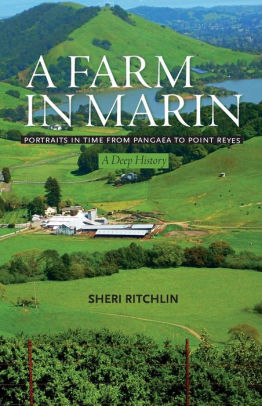By Silas Valentino - Point Reyes Light - February 8, 2018
It’s a timeless tale: people emigrate from their countries of origin for a chance at prosperity in America. In West Marin, many of the early settlers who established dairies and ranches with names still recognizable today hailed from the same region of Switzerland, near the border of Italy.
The bridge between Ticino, Switzerland and West Marin receives a thorough historical polishing in a new book by Sheri Ritchlin, “A Farm in Marin: Portraits in Time from Pangea to Point Reyes.” It’s chockablock with deeply researched information to reflect the past from both sides of the immigrant’s journey.
Ms. Ritchlin begins her investigation with the chapter called “Earth Time,” which briefly reinterprets North America’s 15 billion-year-old existence, before following migration patterns from ancient Rome to Milan and, finally, Ticino. Spliced throughout the book are personal anecdotes of her own story in West Marin and family tales from the farm she lived on.
Ms. Ritchlin, who splits her time between West Marin and Ovando, Montana, built her book on interviews with descendants, newspaper clippings, diary entries and fully reprinted, 19th-century letters from the likes of Oscar Shafter, whose family held a land empire on Point Reyes. The book, published by Pointer Oak in October, was the result of 10 years of writing and a successful Kickstarter campaign.
West Marin’s past first captured Ms. Ritchlin while she was a student at the California Institute of Integral Studies over a decade ago. She was living in a 1972 cabover camper at the Ed and Susie Grossi ranch, near the Sonoma County border, where she helped in the vegetable garden. Anecdotes of the family’s origins piqued her interest and she began her research, using the Grossis as her north star. David Rolland’s “Light on the Old Country” series in the Light from the 1990s, for which the writer traveled to Switzerland and Croatia to report on West Marin’s early ancestors, was one of the book’s inspirations.
Many West Marin ranch families immigrated to the States from the same corner of the Alps: Ticino (pronounced Ti-CHEE-no). The Italian-speaking region is located in southern Switzerland, close to Milan. While Ticino features rolling green hills akin to West Marin’s, the Swiss Alps are more rugged and sharp—think Matterhorn, not Black Mountain.
The more information Ms. Ritchlin dug up, the clearer the bridge between these places came into view.
The Swiss immigrants began arriving in waves to West Marin, following in the footsteps of their family and fellow Ticino villagers until the ’30s when the United States government slapped quotas on immigration. “Word in Ticino was, ‘Look for old man Grandi, he speaks the language and he’ll help you find a job,’” she said.
The names of the immigrants who poured into West Marin during the second half of the 19th century read like the freshman orientation of West Marin’s first graduating class: Spaletta, Martinelli, Dolcini, Grossi, Cheda and Giacomini.
“In 1860, we find Antonio Jacomeni (as spelled on the census) working on a ranch in Tomales,” she writes. The 1870 census showed that of the 320 people living in Olema, 47 were dairy workers from Ticino, including seven Cheda family members.
By 1886, the Marin Independent Journal would report that of the 8,000 Ticinesi living in California, “about one third reside in Marin County.”
“Already, the Ticinesi are beginning to leave their mark on the Marin landscape, bringing with them the humble skills that had been essential to their survival along the steep valleys of southern Switzerland and will now bring them a share of California gold,” Ms. Ritchlin writes.
Sadly, an unfortunate thread of xenophobia also connects yesteryear with today. Letters to the editor of that era revealed complaints about how these new neighbors were acquiring land and job opportunities. “California is going, and will keep on going to ruin, if these detestable Swiss, Portuguese and Chinese are not politely invited by Uncle Sam to take up their bed and walk to—well, to the shades from whence they came I suppose,” an unidentified “unemployed man” in Olema wrote to the I.J. in January 1870.
But not all reactions to the influx of immigrants were negative. Historian Dewey Livingston dug up a quote from 1881, sourced from an unknown speaker in Olema, that depicted a community beginning to meld together, if with the help of humor: “Several marriages have taken place among the Swiss population. We should give their names to an expectant public, if in the first place we could remember them, and if in the second place we could spell them.”
************
'A Farm in Marin: Portraits in Time from Pangea to Point Reyes' (By Sheri Ritchlin - 2017)
************
Businesses advertised withing the article, owned by a few of the old local Ticinese families....
.






No comments:
Post a Comment